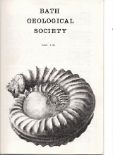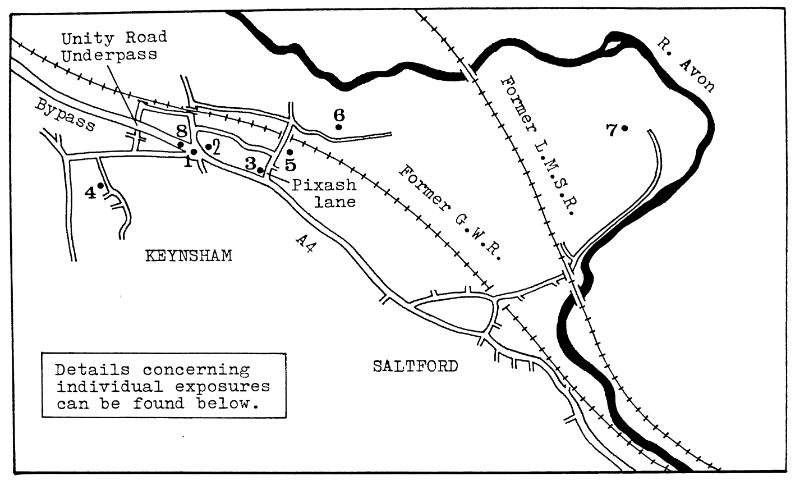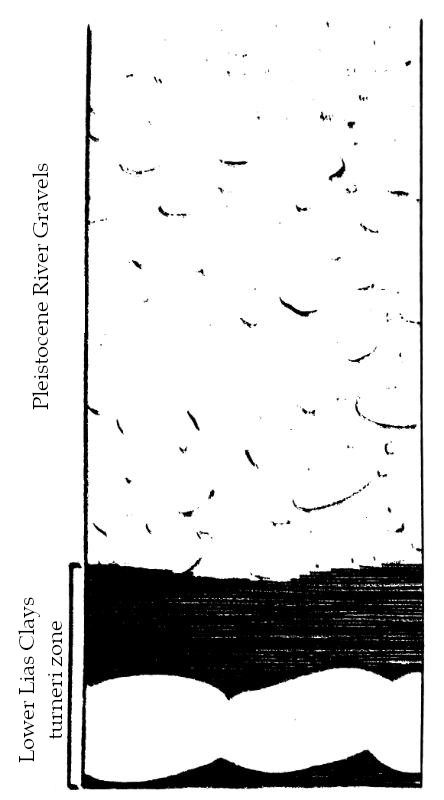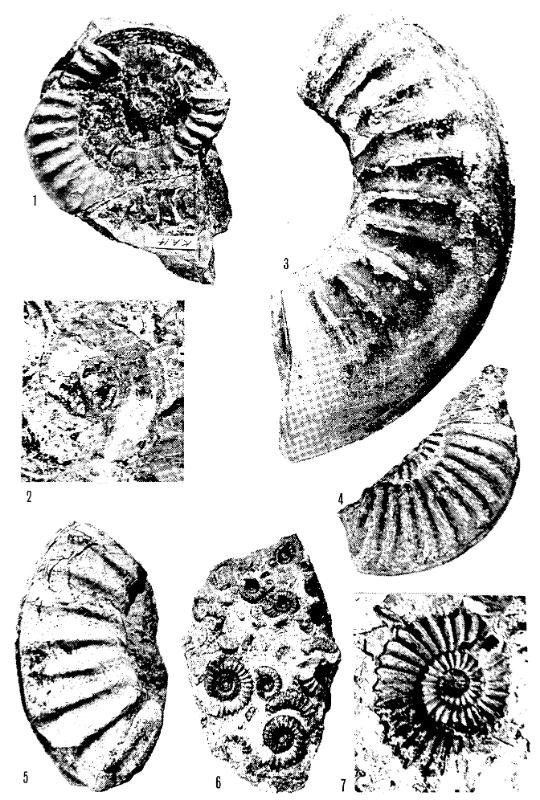A Recent Exposure of the Lower Lias Clay at Keynsham

In June 1984 work commenced on the construction of a new Civic Amenity site in Keynsham. The site chosen was a field adjoining the former Great Western Railway at Pixash Lane. (O.S.676183)
Excavations for drains and foundations exposed beds belonging to the turneri zone of the Lower Lias Clays. These beds, situated above the Blue Lias, are only rarely exposed in this district so a detailed record of this section was made.
Tutcher (1923, pp. 270-271) recorded both turneri and obtusum zones at Saltford Mead which lies only a few miles east of this site. He was unable to record an accurate succession in the Lower Lias Clays as construction work had already been partially completed when the site was visited by him, much of the information regarding the position of the beds was provided by a Clerk of Works.
The turneri zone is characterised in this area by a predominance of clay. Bands of limestone and septarian nodules do, however, occur at certain horizons.
At the base of this exposure a line of septarian nodules were recorded and an example of the subzonal ammonite, Microderoceras birchi (J. Sowerby) extracted from them, along with an associated ammonite fauna which included Promicroceras sp., and Cymbites sp. Above these nodules was 1 foot (0.30m) of dark clay capped by several feet of river gravels and alluvium.
At Saltford Mead Tutcher (1923, pp. 270-271) also recorded septarian nodules with Asteroceras, indicative of the obtusum zone, in situ. At the Pixash Lane site these nodules, as well as some of the underlying beds of the turneri zone have been removed by erosion. The occasional fragment of an Asteroceras, or weathered nodule with Promicroceras and Caenisites in the river gravels prove their former existence here.
From the examination of the excavated material from the Pixash lane site, it was evident that beds below the septarian nodule bed were exposed previous to my visit but were now obscured. Nodules of a different lithic character were observed, light in colour, heavily pyritised and more lenticular in shape, as well as thin, impersistent beds of highly pyritised limestone. No ammonites were found in these lower beds.
Mr. T.R. Fry, recorded derived material from the turneri and obtusum zones in the river gravels which were formally extracted from the gravel pits on land at Stidham Farm, a short distance from the Pixash lane site. The material is represented by examples of the ammonites Caenisites and Asteroceras.
A specimen of Caenisites turneri (J. de C. Sowerby) was also found by Mr. T.R. Fry during temporary excavations at Chandag Road, Keynsham. More recently Mr. A. Bentley (1962) recorded several temporary sections in the lower Lias Clays, in connection with building works in the vicinity of the former Mothers Pride Bakery site, at Keynsham. The sections recorded show conclusively that the beds exposed here belong to the obtusum zone and represent the highest beds of the Lower Lias to be preserved in the Keynsham area.
A characteristic clay succession was recorded in which bands of limestone nodules and septaria were developed. The following ammonites were recorded by Mr. A. Bentley: Asteroceras obtusum (J. Sowerby), Promicroceras planicosta (J. Sowerby), Promicroceras capricornoides (Spath), Xipheroceras cf. rasinodum (Quenstedt), Cymbites laevigatus (J. de C. Sowerby) and Eopophioceras landrioti (d’Orbigny).
During construction of the Keynsham Bypass, Mr. A. Bentley (1964) recorded two nodule beds at surface exposures east of the Unity Road Underpass. Caenisites was collected from one nodule bed, while the other, which was in close proximity to Exposure 1 (Fig 1) yielded an Asteroceras.
Acknowledgements I would like to thank Professor. D.T. Donovan for his identification of the ammonites and Mrs. S. Tutty for providing the excellent photograph of the specimens included here.
Figure 1: Map showing Lower Lias Clay exposures in the Keynsham and Saltford area.

Exposure 1. Mothers Pride Bakery Sections, Keynsham. obtusum zone
Mr. A. Bentley, 1962, Page 1, Section 1
Temporary exposure (Grid Reference O.S. 665683)
Exposure 2. Mothers Pride Bakery Sections, Keynsham. obtusum zone
Mr. A. Bentley, 1962, Page 1, Section 2
Temporary exposure (Grid Reference O.S. 666683)
Exposure 3. Mothers Pride Bakery Sections, Keynsham. obtusum zone
Mr. A. Bentley, 1962, Page 2, Section 3
Temporary exposure (Grid Reference O.S. 669681)
Exposure 4. Chandag Road, Keynsham. turneri zone
Mr. T. A. Fry. Personal communication. 666081)
Temporary exposure (Grid Reference O.S. 666081)
Exposure 5. Pixash Lane, Keynsham. turneri zone (River gravels with derived nodules from the obtusum zone)
Mr. S. Carpenter, 1984 (as described in this account)
Temporary exposure (Grid Reference O.S. 671683)
Exposure 6. Stidham Farm Gravel Pit, Keynsham. River gravels with derived nodules from the turneri and obtusum zones. Clays of the turneri zone were recorded at the base of the Pit
Mr. T. R. Fry. Personal communication.
The Pit is no longer visible (Grid Reference O.S. 674684)
Exposure 7. Bath Corporation Sewage Works, Saltford meade. Turneri and obtusum zones.
Mr. J. W. Tutcher, 1923, Page 270-271.
Temporary exposure (Grid Reference O.S. 692684)
Exposure 8. Keynsham Bypass. turneri and obtusum zones
Mr. A. Bentley, 1964, Page 11
Temporary exposure (Grid Reference O.S. 665683)
Figure 2: Diagrammatic vertical section through the Pleistocene river gravels and Lower Lias Clay at Pixash Lane, Keynsham. 1984

Plate 1

References
- Bentley, A. 1962–67 Notes on temporary exposures in the Jurassic rocks of the Bristol and Bath areas. Unpublished. Bristol Museum, Geology Department.
- Dean, W.T., Donovan, D.T and Howarth, M.K. 1961 The liassic ammonite zones and subzones of the north-west European Province. Bull. Br. Mus. (Nat Hist.). Geology, Vol.4, No. 10, pp. 435-505.
- Donovan, D.T., and Kellaway, G.A. 1984 Geology of the Bristol District: the lower Jurassic Rocks. Mem. Br. Geol. Surv., 69 pp.
- Fry, T.R. Personal Communication. (Stidham Farm gravel pit and Caenisites at Chandag Road, Keynsham)
- Tutcher, J.W. 1923 Some recent exposures of the Lias (Sinemurian and Hettangian) and Rhaetic about Keynsham. Proc. Bristol Nat. Soc., Ser. 4, Vol. 5, pp. 268–278.
